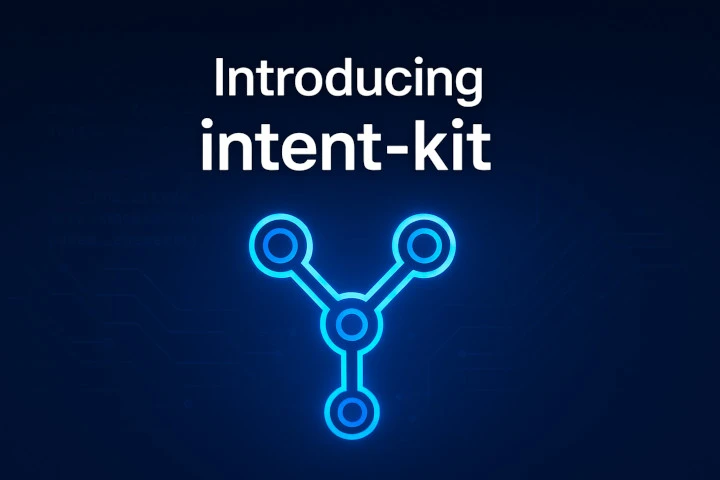Introducing intent-kit: Universal, Deterministic Intent Workflows for Python


Key Points
What problem does intent-kit aim to solve for teams building AI-powered tools?
Intent-kit addresses the challenges of unpredictability and inflexibility in existing LLM-based and rule-based workflows. It helps teams avoid reinventing complex routing systems and offers a predictable, composable, and production-ready way to build and maintain AI-powered tools like chatbots or workflow automations.
How does intent-kit enable more reliability and control compared to typical LLM or rule-based approaches?
Intent-kit allows developers to define all valid intents, parameters, and context up front, ensuring deterministic behavior and eliminating surprises. It supports mixing classic (rule-based) and AI-powered routing, letting users test and inspect all steps to guarantee reliability and control.
What types of workflows and routing can be built with intent-kit?
You can build hierarchical 'intent graphs' that route user inputs through combinations of keyword, regex, custom machine learning, and LLM classifiers. This flexible architecture lets you create chatbots, automation tools, or custom workflow apps that blend AI and traditional methods.
Why is the Eval API feature valuable for production workflows?
The Eval API allows testing workflows against real datasets in formats like YAML or JSON, automating validation and spotting issues before deployment. This removes the need for manual testing, ensures coverage of edge cases, and provides actionable reporting for greater confidence in production systems.
In what ways is intent-kit designed for extensibility and real-world production use?
Intent-kit is universal and extensible: it works with any classification approach and has no hard dependencies by default. You can add LLMs, custom business logic, or APIs as needed. It's built with testability and debuggability in mind, ensuring it's suitable for long-term, maintainable products used by other companies.
If you’ve spent any time trying to build reliable LLM-powered tools, you know the pain: Most startups and teams re-invent the wheel every time they want to build a chatbot, automation, or AI-powered workflow that’s both smart and deterministic.
LLMs are powerful-but they’re unpredictable, hard to constrain, and most libraries either go “all in” on black-box AI or fall back to brittle, rule-based matching. When you want composability, reliability, and auditability (especially in a product you’re delivering to someone else), you’re left cobbling together hacks. That’s why I built intent-kit.
What is intent-kit?
intent-kit is a universal Python framework for building intent-driven classification and execution systems-chatbots, automation tools, or custom workflow apps-using any combination of rule-based logic, LLMs, or custom classifiers. It’s designed for developers and product teams who need to:
- Define all capabilities, constraints, and dependencies up front
- Mix and match classic and AI-driven routing in the same workflow
- Build systems that are predictable, testable, and production-safe
- Escape both “spaghetti rules” and “LLM guesswork”
intent-kit lets you wire up hierarchical “intent graphs,” route inputs through any number of classifiers (from simple keywords to the latest LLMs), and always know exactly what’s happening at every step.
Why does intent-kit exist?
After seeing team after team run into the same problems-
- Overly complex, one-off intent routers
- Rule-based systems that don’t scale
- Messy, untestable parameter extraction
- Product demos that never become maintainable products
-I realized there was a missing piece: A framework that’s flexible enough for AI, reliable enough for enterprise, and open-ended enough to be used for any workflow. Not just another chatbot framework or hacky script, but something composable, deterministic, and actually production-ready.
How is intent-kit different?
intent-kit isn’t just another “prompt router” or chatbot SDK. It’s:
- Universal: Works with any classification method-keyword, regex, custom ML, or LLM-zero dependencies by default.
- Deterministic & Composable: You define all valid intents, parameters, and context up front. No surprises, no hallucinations, no “magic.”
- Extensible: Add LLMs only if/when you need them. Plug in your own business logic, APIs, or classifiers.
- Testable & Debuggable: Parameter extraction, routing, and context flow are all inspectable, unit-testable, and production-ready.
- Production Focused: Built for building tools for other companies-not just for demos, but for products you need to maintain.
Most importantly: you’re always in control. intent-kit doesn’t do anything you didn’t define-so you can deliver products that are both “AI-powered” and robust enough for real users.
Eval API: Test Your Workflows with Real Data
A powerful feature of intent-kit is its built-in Eval API. You can supply your own datasets-structured as YAML or JSON examples (see repo examples)-to automatically test and validate your entire workflow against a wide range of user inputs and edge cases.
- No more hand-testing: Evaluate how your graph/classifiers perform on real data, not just your best guesses.
- Customize your evals: Bring your own domain-specific cases and regression tests.
- Actionable reporting: Quickly spot gaps, errors, or unintended behaviors before you ship.
This means you can confidently ship deterministic, AI-powered workflows-knowing exactly how your system will respond in the wild.
Learn More / Get Started
-
Read the docs: docs.intentkit.io
-
Get the code: github.com/Stephen-Collins-tech/intent-kit
-
See examples and demos in the docs, or try the package locally with:
pip install intent-kit pip install intent-kit[openai] # to use OpenAI's SDK -
Questions or feedback? Open a GitHub issue or DM me on LinkedIn.
Stop gluing together broken workflows.
Start building with intent.